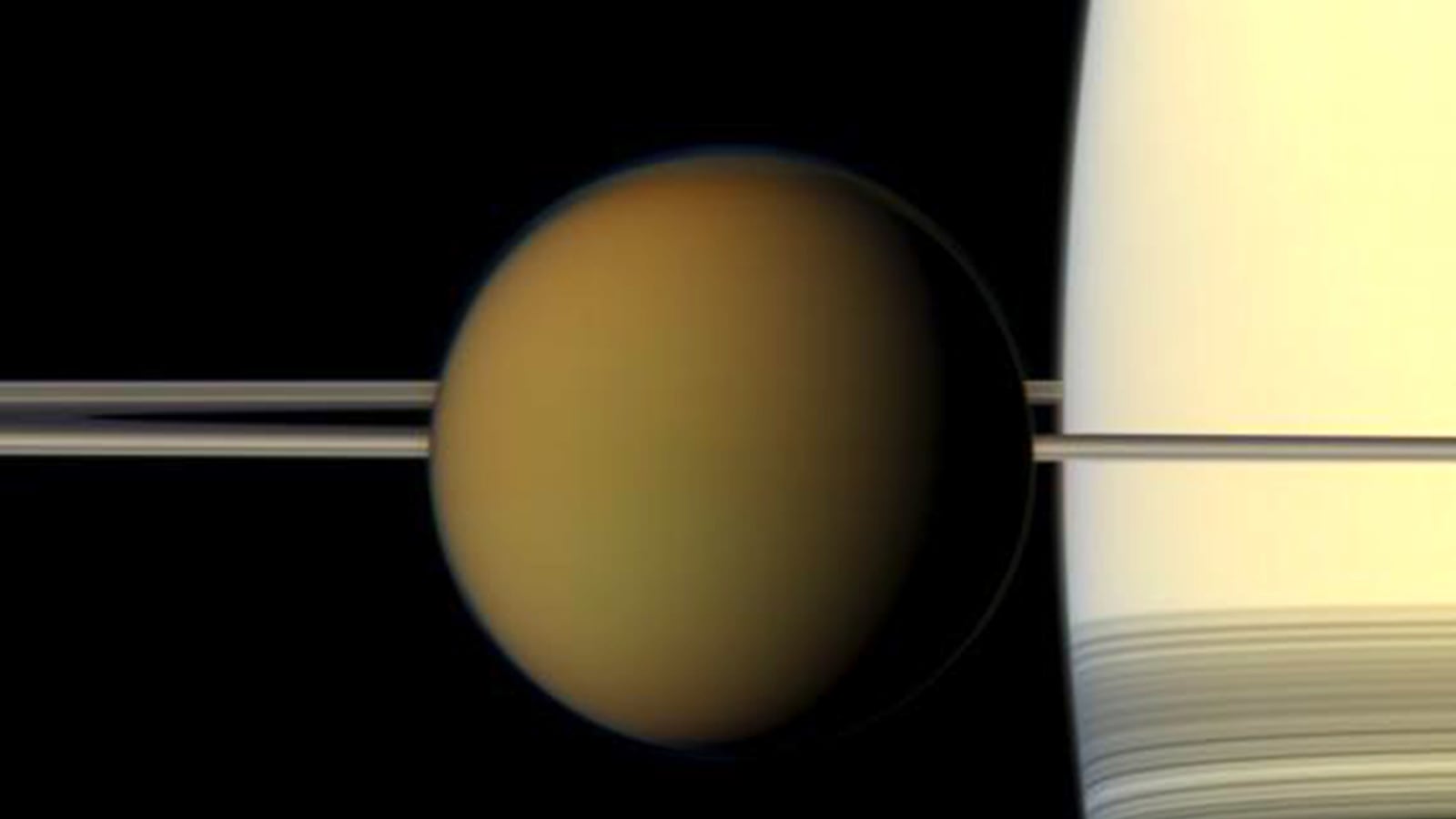Saturn’s giant moon Titan is much like Earth, with its nitrogen atmosphere, weather driven by seasonal changes, sand dunes, and liquid lakes on its surface. That is, if Earth was much smaller, deeply cold, completely full of smog, and possessed of lakes of methane and boulders of hard-frozen water.
Yet both its similarities and differences from Earth make Titan very interesting. Like Earth, Titan has weather, with evaporation, clouds, rain, and wind. It’s also the only Solar System body known to have lakes and rivers. Unlike Earth, Titan’s lakes, rain, and weather involve methane instead of water, but the cycle of evaporation and rain are very similar.
However, it’s hard to study Titanian meteorology: the weather changes slowly and subtly, thanks to the much slower pace of seasons and thicker atmosphere. That’s why seeing the formation and motion of a single large cloud system on Titan is exciting. Summer began in the moon’s northern hemisphere recently, but the expected storms (seen in the southern hemisphere earlier) haven’t arrived yet. These clouds, spotted over a methane lake, could be the first sign of summer rains on a distant world.
Cloud watching is important. Clouds carry material—water on Earth, methane on Titan—from one part of the atmosphere to another. They’re a way a world carries liquid from one region to another, in the form of evaporation and rain. A lake may dry up in one region, but a new one can form when rains fill a basin elsewhere. We know very well how that process works on Earth, but Titan’s weather is still mysterious in many ways.
But that’s one part of the mission of the Cassini probe orbiting Saturn. Titan is the Solar System’s second-largest moon, bigger than both Earth’s Moon and the planet Mercury. However, its composition and interior are very different than the Moon. Under its frozen surface Titan has a global ocean of salty water, a feature it shares with other outer Solar System moons: Enceladus, Europa, and others.
It is also the only moon to possess a substantial atmosphere—and in fact it’s slightly thicker than ours, though not breathable. Titan’s atmosphere, like Earth’s, is mostly nitrogen, but instead of oxygen and water to make up the balance, it has hydrocarbons: methane, ethane, propane, and other similar molecules made of carbon and hydrogen. On Earth, those chemicals are mostly in the air due to pollution, where they make the stinky yellowish haze of smog; on Titan, they occur naturally, but they still color the atmosphere to give the moon its distinctive orange color.
Seasons on Earth and Titan are both due to the tilt of their axis—the way the North Pole faces—relative to their orbit. Titan’s axial tilt is aligned with Saturn’s, which is at a larger angle than Earth’s, resulting in more dramatic seasonal changes on both the planet and its moon. Since one year on Saturn lasts roughly 29.5 Earth years, each season is a little more than seven Earth-years long.
Because Titan is so far from the Sun, its surface is about -180º C (-292º F), far too cold for liquid water or much atmospheric water. That means Titan’s lakes, rivers, and clouds are made of methane, which has a lower freezing point. Because Titan is the only Solar System body other than Earth with liquid lakes on its surface, its cycle of evaporation and precipitation make it more Earth-like even than Mars.
That brings us back to the cloud system monitored by the Cassini mission between July 20 and 22. The clouds appeared to form over Titan’s second-largest methane lake, Ligeia Mare. (“Mare” is pronounced “MAR-ay,” meaning “sea” in Latin. All the mares on Titan are named for mythical creatures; Ligeia was one of the Sirens from Greek mythology.) Researchers aren’t sure if the clouds were actually from lake evaporation, but the evidence is suggestive.
During their three-day life, the clouds moved from their point of formation as though carried by wind blowing as fast as 16 km/hour (10 mph). That itself is vital information, since without a ground-based weather station, researchers have to rely on cloud motion or other measures for determining wind speed. As with Earth, Titan’s winds are driven by temperature differences across the world, as the Sun warms the air slightly.
However, one cloud system does not a summer make on Titan. Computer simulations of the moon’s atmosphere predict summer storms, with many more clouds. Whether this three-day system is a harbinger of seasonal weather changes is uncertain. The planetary scientists working on the Cassini mission will continue to cloud-watch the moon to see if theoretical models are right, or if something strange is going on.
An even better idea would be to return to Titan’s surface with a new probe. Cassini carried the Huygens lander, which descended to the surface for a brief period of study in 2005, but that was a stationary probe. The proposed Titan Mare Explorer (TiME), for example, would place a boat on either Ligeia Mare or Kraken Mare. (And who wouldn’t want to land a boat in Kraken Mare?) However, TiME—like most outer Solar System missions—is not in NASA’s plans for the near future.
In some ways, Titan bears some resemblance to early Earth, while in others it exhibits its unique history and position in the outer Solar System. Despite the liquid lakes and nitrogen atmosphere, it’s unlikely to be a good candidate for life as we know it. Nevertheless, every world brings us closer to an understanding of how planets form, helping us comprehend our own origins.






